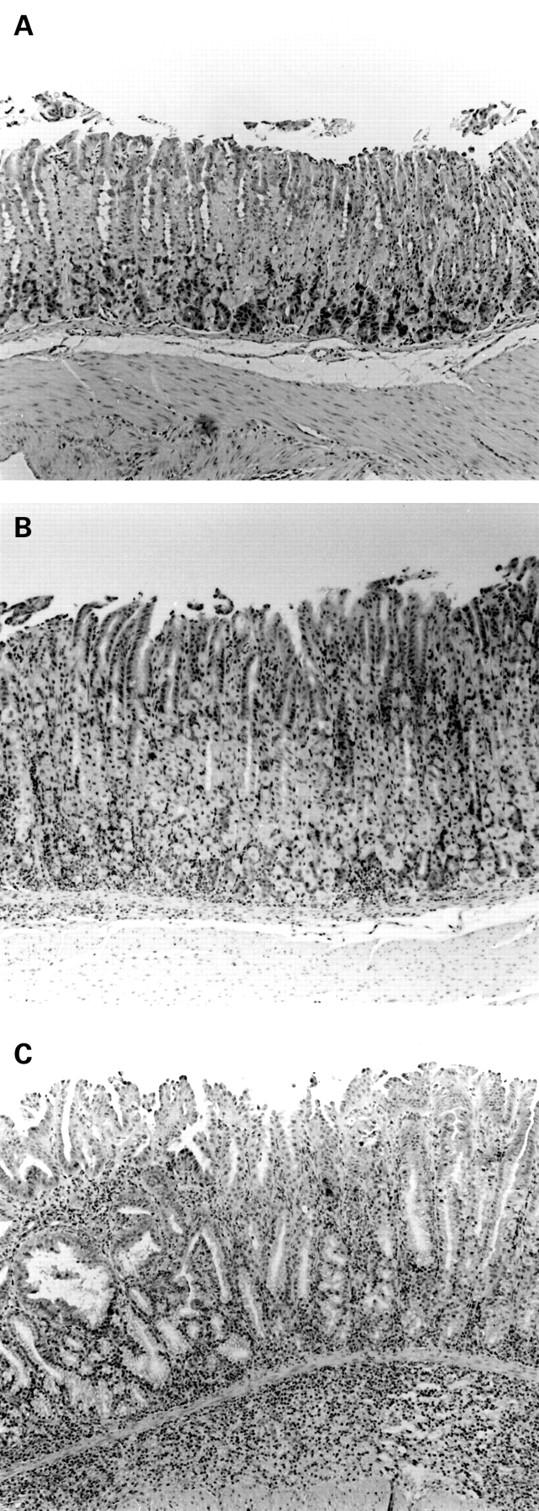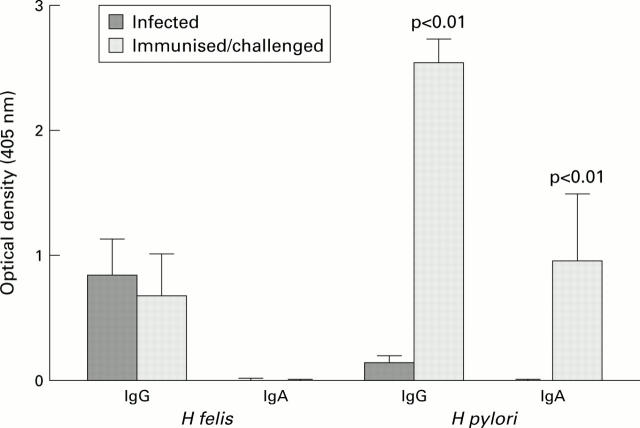Abstract
BACKGROUND AND AIMS—Helicobacter pylori is a major cause of peptic ulcers and gastric cancer. Vaccine development is progressing but there is concern that immunisation may exacerbate Helicobacter induced gastritis: prophylactic immunisation followed by challenge with H felis or H pylori can induce a more severe gastritis in mice than seen with infection alone. The aim of this study was to investigate the relationship between immunity to Helicobacter infection and post-immunisation gastritis. METHODS—(1) C57BL/6 mice were prophylactically immunised before challenge with either H felis or H pylori. Histopathology and colonisation were assessed one month post-challenge. (2) C57BL/6 mice were prophylactically immunised against H felis infection and gastritis assessed up to 18 months post-challenge. RESULTS—Prophylactic immunisation induced a reduction in bacterial colonisation following H felis challenge which was associated with increased severity of active gastritis with neutrophil infiltration and atrophy. However, immunised mice challenged with H pylori SS1 had little evidence of pathology. Long term follow up showed that post-immunisation gastritis was evident at three months. However, from six months onwards, although immunised/challenged mice still developed gastritis, there was no significant difference between inflammation in these mice and infected controls. Post-immunisation gastritis was not associated with the serum antibody response. Immunisation prevented the formation of secondary lymphoid aggregates in the gastric tissue. CONCLUSION—The H felis mouse model of post-immunisation gastritis is the most extreme example of this type of pathology. We have shown in this model that post-immunisation gastritis is a transient event which does not produce long term exacerbation of pathology. Keywords: Helicobacter; immunisation; post-immunisation gastritis
Full Text
The Full Text of this article is available as a PDF (219.5 KB).
Figure 1 .

Histopathology. Photomicrographs (magnification ×148) are representative of: (A) normal mouse stomach; (B) Helicobacter felis infected stomach with moderate multifocal infiltration of lymphocytes; and (C) post-immunisation gastritis in a mouse prophylactically immunised and then challenged with H felis. The section shown portrays infiltration of lymphocytes, with severe functional atrophy and severe submucosal inflammation.
Figure 2 .
Serum levels of anti-Helicobacter antibodies following immunisation and challenge of mice with Helicobacter. Serum levels of anti-H felis and anti-H pylori IgG and IgA antibodies were assessed by ELISA; the y axis shows optical densities measured at 405 nm. p values show significant differences (Mann-Whitney analysis).
Selected References
These references are in PubMed. This may not be the complete list of references from this article.
- Chen M., Lee A., Hazell S., Hu P., Li Y. Immunisation against gastric infection with Helicobacter species: first step in the prophylaxis of gastric cancer? Zentralbl Bakteriol. 1993 Sep;280(1-2):155–165. doi: 10.1016/s0934-8840(11)80952-7. [DOI] [PubMed] [Google Scholar]
- Chen M., Lee A., Hazell S. Immunisation against gastric helicobacter infection in a mouse/Helicobacter felis model. Lancet. 1992 May 2;339(8801):1120–1121. doi: 10.1016/0140-6736(92)90720-n. [DOI] [PubMed] [Google Scholar]
- Corthésy-Theulaz I., Porta N., Glauser M., Saraga E., Vaney A. C., Haas R., Kraehenbuhl J. P., Blum A. L., Michetti P. Oral immunization with Helicobacter pylori urease B subunit as a treatment against Helicobacter infection in mice. Gastroenterology. 1995 Jul;109(1):115–121. doi: 10.1016/0016-5085(95)90275-9. [DOI] [PubMed] [Google Scholar]
- Czinn S. J., Cai A., Nedrud J. G. Protection of germ-free mice from infection by Helicobacter felis after active oral or passive IgA immunization. Vaccine. 1993;11(6):637–642. doi: 10.1016/0264-410x(93)90309-l. [DOI] [PubMed] [Google Scholar]
- Dieterich C., Bouzourène H., Blum A. L., Corthésy-Theulaz I. E. Urease-based mucosal immunization against Helicobacter heilmannii infection induces corpus atrophy in mice. Infect Immun. 1999 Nov;67(11):6206–6209. doi: 10.1128/iai.67.11.6206-6209.1999. [DOI] [PMC free article] [PubMed] [Google Scholar]
- Doidge C., Crust I., Lee A., Buck F., Hazell S., Manne U. Therapeutic immunisation against Helicobacter infection. Lancet. 1994 Apr 9;343(8902):914–915. doi: 10.1016/s0140-6736(94)90032-9. [DOI] [PubMed] [Google Scholar]
- Ermak T. H., Ding R., Ekstein B., Hill J., Myers G. A., Lee C. K., Pappo J., Kleanthous H. K., Monath T. P. Gastritis in urease-immunized mice after Helicobacter felis challenge may be due to residual bacteria. Gastroenterology. 1997 Oct;113(4):1118–1128. doi: 10.1053/gast.1997.v113.pm9322506. [DOI] [PubMed] [Google Scholar]
- Ermak T. H., Giannasca P. J., Nichols R., Myers G. A., Nedrud J., Weltzin R., Lee C. K., Kleanthous H., Monath T. P. Immunization of mice with urease vaccine affords protection against Helicobacter pylori infection in the absence of antibodies and is mediated by MHC class II-restricted responses. J Exp Med. 1998 Dec 21;188(12):2277–2288. doi: 10.1084/jem.188.12.2277. [DOI] [PMC free article] [PubMed] [Google Scholar]
- Ghiara P., Rossi M., Marchetti M., Di Tommaso A., Vindigni C., Ciampolini F., Covacci A., Telford J. L., De Magistris M. T., Pizza M. Therapeutic intragastric vaccination against Helicobacter pylori in mice eradicates an otherwise chronic infection and confers protection against reinfection. Infect Immun. 1997 Dec;65(12):4996–5002. doi: 10.1128/iai.65.12.4996-5002.1997. [DOI] [PMC free article] [PubMed] [Google Scholar]
- Goto T., Nishizono A., Fujioka T., Ikewaki J., Mifune K., Nasu M. Local secretory immunoglobulin A and postimmunization gastritis correlate with protection against Helicobacter pylori infection after oral vaccination of mice. Infect Immun. 1999 May;67(5):2531–2539. doi: 10.1128/iai.67.5.2531-2539.1999. [DOI] [PMC free article] [PubMed] [Google Scholar]
- Isaacson P. G. Gastric MALT lymphoma: from concept to cure. Ann Oncol. 1999 Jun;10(6):637–645. doi: 10.1023/a:1008396618983. [DOI] [PubMed] [Google Scholar]
- Isaacson P. G. Mucosa-associated lymphoid tissue lymphoma. Semin Hematol. 1999 Apr;36(2):139–147. [PubMed] [Google Scholar]
- Lee A., Fox J. G., Otto G., Murphy J. A small animal model of human Helicobacter pylori active chronic gastritis. Gastroenterology. 1990 Nov;99(5):1315–1323. doi: 10.1016/0016-5085(90)91156-z. [DOI] [PubMed] [Google Scholar]
- Lee A., O'Rourke J., De Ungria M. C., Robertson B., Daskalopoulos G., Dixon M. F. A standardized mouse model of Helicobacter pylori infection: introducing the Sydney strain. Gastroenterology. 1997 Apr;112(4):1386–1397. doi: 10.1016/s0016-5085(97)70155-0. [DOI] [PubMed] [Google Scholar]
- Michetti P., Corthésy-Theulaz I., Davin C., Haas R., Vaney A. C., Heitz M., Bille J., Kraehenbuhl J. P., Saraga E., Blum A. L. Immunization of BALB/c mice against Helicobacter felis infection with Helicobacter pylori urease. Gastroenterology. 1994 Oct;107(4):1002–1011. doi: 10.1016/0016-5085(94)90224-0. [DOI] [PubMed] [Google Scholar]
- Mégraud F. Antibiotic resistance in Helicobacter pylori infection. Br Med Bull. 1998;54(1):207–216. doi: 10.1093/oxfordjournals.bmb.a011671. [DOI] [PubMed] [Google Scholar]
- NIH Consensus Conference. Helicobacter pylori in peptic ulcer disease. NIH Consensus Development Panel on Helicobacter pylori in Peptic Ulcer Disease. JAMA. 1994 Jul 6;272(1):65–69. [PubMed] [Google Scholar]
- Pappo J., Torrey D., Castriotta L., Savinainen A., Kabok Z., Ibraghimov A. Helicobacter pylori infection in immunized mice lacking major histocompatibility complex class I and class II functions. Infect Immun. 1999 Jan;67(1):337–341. doi: 10.1128/iai.67.1.337-341.1999. [DOI] [PMC free article] [PubMed] [Google Scholar]
- Radcliff F. J., Hazell S. L., Kolesnikow T., Doidge C., Lee A. Catalase, a novel antigen for Helicobacter pylori vaccination. Infect Immun. 1997 Nov;65(11):4668–4674. doi: 10.1128/iai.65.11.4668-4674.1997. [DOI] [PMC free article] [PubMed] [Google Scholar]
- Sutton P., Wilson J., Genta R., Torrey D., Savinainen A., Pappo J., Lee A. A genetic basis for atrophy: dominant non-responsiveness and helicobacter induced gastritis in F(1) hybrid mice. Gut. 1999 Sep;45(3):335–340. doi: 10.1136/gut.45.3.335. [DOI] [PMC free article] [PubMed] [Google Scholar]




